Programs give homeless care the top priority
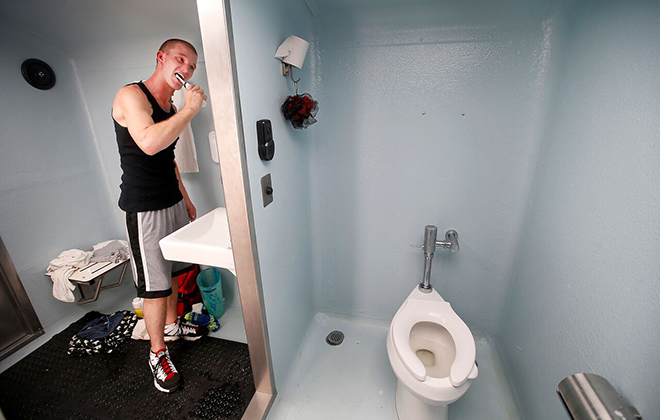
Kevin Culling, 24, brushes his teeth inside an old San Francisco Muni bus that was converted into a mo- bile shower and toilet to aid the city’s homeless population.
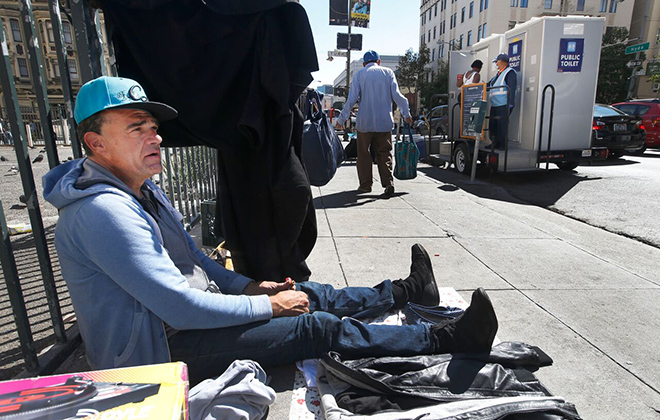
San Francisco’s Department of Public Works operates the Pit Stop program, which provides clean public toilets, used-needle receptacles and dog waste stations. Above, Joey Persie says the toilets have helped clean up the area.

Above, attendant Dick Meimban logs each visit to the pair of portable public toilets at the Tenderloin Pit Stop in San Francisco.
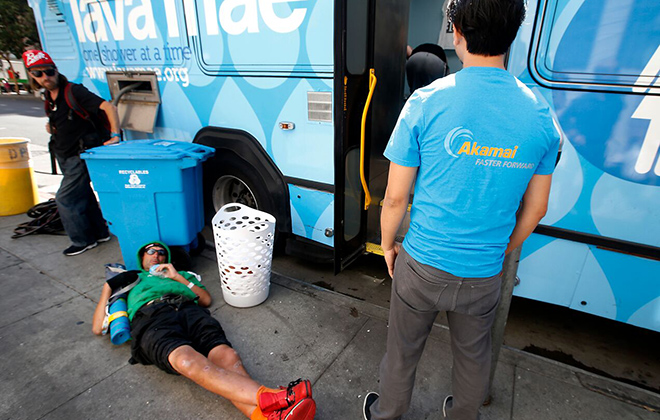
An employee from nearby company Akamai Technologies volunteers outside the Lava Mae bus parked in the Tenderloin District.
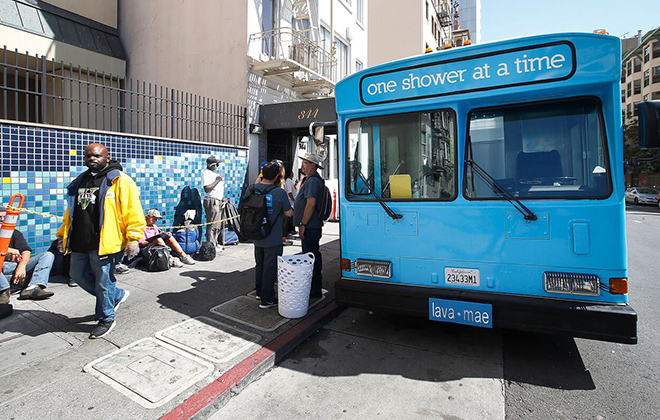
The motto of the nonprofit group that runs the shower-buses is “De- livering Dignity One Shower at a Time.” In Spanish, “lavame” means “wash me.”
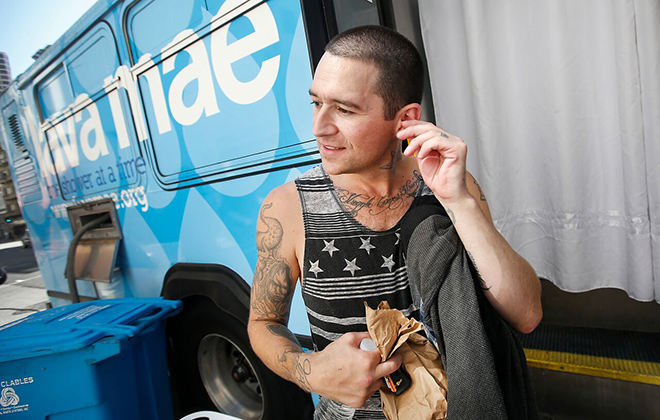
Ryan Ramirez finishes taking a shower on the Lava Mae bus parked in the Tenderloin District. Ramirez and his buddy Kevin Culling lost their jobs, got kicked out of their rental home then spent the next week on some of San Francisco’s toughest streets.






SAN FRANCISCO >> Ryan Ramirez, 31, had gone three days without cleaning himself when he brushed his teeth and enjoyed a hot shower inside an abandoned city bus that has been converted into a mobile hygiene station for homeless people like him.
Ramirez and his buddy, Kevin Culling, 24, lost their jobs as carpenters, then got kicked out of their rental home. They spent the next week on some of San Francisco’s toughest streets in a dirt-stained, 2013 white Chevrolet Malibu and searched for days looking for any bathroom, shower or sink for basic hygiene.
As he spat out the first toothpaste that he had tasted in 72 hours, Ramirez told the Honolulu Star-Advertiser that Honolulu officials should “definitely” turn some of their own discarded city buses into mobile showers that are helping keep San Francisco’s sidewalks clean of urine, feces and discarded needles — giving people like him a sense of dignity.
“It’s a good feeling,” Ramirez said inside the old San Francisco “Muni” bus that had been painted powder blue, re-engineered and converted to operate two separate, private areas that each contain a single hot-water shower, toilet, sink, donated towels, soap and toiletry kits.
“It’s great,” Ramirez said. “Much appreciated.”
The motto of the Lava Mae nonprofit group that runs the so-called shower-buses is “Delivering Dignity One Shower at a Time.” In Spanish, “lavame” (LA-va-mae) means “wash me.”
Don't miss out on what's happening!
Stay in touch with breaking news, as it happens, conveniently in your email inbox. It's FREE!
It’s part of a diverse effort by San Francisco’s nonprofit organizations and government officials who are doing things unseen in Hawaii to deal with a rampant homeless population in one of America’s most expensive and beloved cities.
The projects include converting an empty public school into the city’s latest homeless shelter where an Episcopal Church group is helping to test new ideas in the heart of San Francisco’s Mission District.
The “Navigation Center” opened in March and allows communities of homeless friends — and, just as importantly, their pets — to live together in a protected environment where their belongings will be secure and they are surrounded by social service case workers helping with their issues.
In both San Francisco and Honolulu — like other cities across the country — “pets create a barrier for people seeking shelter,” said Mary Steiner, policy advocate for the Hawaiian Humane Society. “Currently, Hawaii’s shelters are not pet-friendly. People will choose to live on the streets with their pets, rather than give them up if they believe it is their only option.”
San Francisco is also embracing the “Housing First” concept under the premise that it’s more effective and cost-efficient to house homeless people first, then begin the process to help them kick alcohol and drugs and start turning their lives around.
While Seattle has spent millions building new projects devoted to housing the homeless in pricey neighborhoods, San Francisco has converted what used to be called “flop houses” — they’re now known as “single-room occupancy hotels” — into Housing First models that also include so-called “wraparound” social and medical services like the ones offered in Seattle.
In San Francisco, the “SROs” are located in some of the city’s grimiest neighborhoods, such as the notorious Tenderloin District just a few short blocks from the epicenter of a major technology conference this month that drove hotel room prices to $600 and above for a single night.
Other converted SROs have opened in the nearby Mission and SoMa (South of Market) districts.
Like the Lava Mae nonprofit organization, the city’s Department of Public Works also is generating interest from across the country with its program that hauls pairs of portable toilets to the streets most affected by homelessness.
“They operate in challenging neighborhoods where there’s a lot of street behavior that’s not always positive to the environment: public drug use, drug dealing, inebriation, prostitution,” said Rachel Gordon, spokeswoman for the city’s Department of Public Works, which partners with various groups to run the rapidly expanding “Pit Stop” program.
Operating for just more than a year, Pit Stop is generating interest from housing officials in Honolulu, Denver, San Diego, Los Angeles and Portland, Gordon said.
The Pit Stop program goes far beyond traditional portable toilets found at public events and construction sites that can be little more than a private hole filled with urine and feces.
WHY SAN FRANCISCO?Like Honolulu, San Francisco is a dense urban city with high housing costs that also draws millions of tourists every year to streets populated with the homeless. San Francisco has also embraced the “Housing First” concept and, in an effort to get more people into shelters, has set “low barriers to entry” which include allowing homeless to bring pets. |
The Pit Stop toilets flush and include sinks with running water, soap, paper towels and toilet paper. They’re also staffed by employees who are often homeless themselves, which has turned out to be a critical part of the program and is winning over skeptics, Gordon said.
The employees come out of government and nonprofit job training programs and earn between $12.75 and $16 an hour, which is just above San Francisco’s $12.25 hourly minimum wage.
They’re responsible for cleaning the Pit Stops after every use and knock on the door after five minutes to make sure nothing inappropriate is going on.
The Pit Stop sites are also outfitted with bags for pet poop. And the employees who monitor the toilets frequently have to dispose of used needles that otherwise might be left on sidewalks traversed by unsuspecting tourists who pour through the city.
Each visit is logged and each pair of portable Pit Stop toilets averages about 100 uses per day, Gordon said.
“Because we have the attendant, more people are using them and we’re seeing a growing increase of women,” Gordon said. “The demand is high and a lot of neighborhoods are clamoring for them, even the high-tourists areas where there aren’t many toilets.”
After just six months as a pilot program titled the “Tenderloin Pit Stop,” demand grew across San Francisco. So the city re-branded the concept into the San Francisco Pit Stop, and duplicate Pit Stops are now towed five days a week into the Castro, Civic Center, Mid-Market, Mission and SoMa districts.
Each pair of toilets costs $100,000 per location to operate annually, including salaries.
The initial idea got pushback from organizations including the San Francisco Police Department that worried they would become magnets for drug dealing, prostitution and other illegal activities, Gordon said.
“The cops in the Tenderloin were particularly dubious about public toilets,” Gordon said. “They quickly turned around when they saw the benefits of having a staff person there.”
The Pit Stops are also cost-effective, she said.
On average, the city spends $1.5 million every six months to accommodate 7,500 requests to steam-clean city streets. More than half of all requests — 58 percent — are related to feces and urine.
“In the Tenderloin, steam-cleaning requests went down 17 percent in the first year,” Gordon said. “It surprised a lot of us. Politics is often a blood sport in San Francisco and people are ready to argue about anything. With this program, all the elected officials have been very supportive and have included increased funding. Bureaucrats, like us, like it because it gives people an alternative to doing their business between parked cars and doorways. And businesses certainly like it. On all fronts it’s been very positive.”
Angelo Partemi, 33, has a home in nearby Mill Valley and uses the Pit Stops when he can’t find a bathroom while visiting San Francisco.
Partemi particularly appreciates that the portable toilets help reduce urine, feces and needles on the sidewalks that he walks over.
On his way back from a job interview in San Francisco, Partemi walked past the original Tenderloin Pit Stop and called it “tremendous.”
“In San Francisco, there’s no place at all to go to the restroom,” Partemi said. “For people on the street, you’re just forcing them to go in public spaces.”
Jun Yang, Honolulu’s executive director for the Office of Housing, has been gathering information and ideas related to both the Pit Stop and shower-bus concepts over the past 18 months.
Even though neither would directly remove any of Honolulu’s homeless from city sidewalks, Yang considers them “great ideas” for an island experiencing yet another consecutive year of record-breaking tourism numbers even as complaints pour in about Honolulu’s homeless population.
“We need to look at all options to help out with the homeless,” Yang said.
Leah Filler is community engagement and mobile services manager for Lava Mae and has been fielding requests for more information from Yang and his housing counterparts around the country.
To get a single donated bus on the road, including parts and servicing, costs about $75,000, Filler said. Annual operating costs for gas, municipal water and such are estimated at another $150,000 to $200,000.
This month, while on vacation on Oahu, Filler visited Yang. She said she would not be surprised if Honolulu becomes the country’s second city to roll out mobile showers made out of discarded buses.
Nearby Palo Alto — home to Stanford University and a red-hot, tech-fueled housing market — tows its new portable showers around on a trailer, much like San Francisco’s Pit Stop program.
But no other community so far has followed Lava Mae’s shower-bus model, Filler said.
In a city with a homeless population of about 7,500, one-sixth of them — or 1,500 people — took showers in Lava Mae’s inaugural bus between June 2014 and this June, Filler said.
This month, Lava Mae unveiled a second bus that offers showers and toilets on the Fulton Street side of San Francisco’s main public library, which frequently finds homeless people washing their feet and bathing in the library’s bathroom sinks.
“We asked to be put on the wait list to park one near the library,” said Michelle Jeffers, spokeswoman for San Francisco’s public library system. “And now people are waiting in line. We certainly are an urban public library and we serve everyone who walks through our doors. We definitely find that people use our bathrooms to clean themselves and we don’t have showers, of course, in our public bathrooms.”
Lava Mae pays the city for the water it pumps out of the library and into both of its shower-buses.
“They run it,” Jeffers said. “We’re not involved. It’s free for clients and free for us, too. Nothing out of pocket for us. We’re always trying to find ways to make sure that we’re providing unique and innovative services and that includes services to our homeless clients.”
San Francisco’s main public library also has a social service worker on duty to help homeless people get access to services.
In response to the inevitable concern that parking a shower-bus will only attract a bigger homeless problem, Lava Mae’s Filler said, “We’re not bringing anybody new into the neighborhood.”
The old buses, towels, soap and toiletry kits are all donated. An on-board water heater converts fire hydrant water into hot showers.
The front half of the old Muni buses already complied with the Americans With Disabilities Act, so homeless people who use wheelchairs can also take advantage of the shower-buses.
Unpaid volunteers — including some who are, or were, homeless — typically organize the waiting lists of people who line up every day. The volunteers also clean each shower after every use.
On a recent day on Ellis Street in the heart of the Tenderloin District, 10 people took showers in the first hour of operation and the waiting list already was more than 2-1/2 hours long.
Three employees from a nearby company called Akamai Technologies were busy volunteering to clean out the showers after every use.
“You see a lot of homeless in San Francisco,” said Akamai employee Neil McKay. “It’s nice to be able to do something. You can tell they appreciate it.”
Paul Asplund, who does not work for Akamai, was on his first day as a Lava Mae volunteer. He had just joined the organization’s board of directors the week before.
Asplund, now 54, had been homeless 27 years ago in Minnesota. At the low point of his time living on the cold streets of Minnesota, Asplund said he went for “two years and five or six months … without taking a shower.”
A chance encounter with a kind-hearted soup kitchen volunteer who offered Asplund a couch and a shower turned out to be the start of Asplund’s journey out of homelessness.
“When I was offered a shower, it was a definitely a key event,” Asplund said. “I don’t want to overplay the sense of relief I felt. But it allowed me to return to society. I know it works.”




